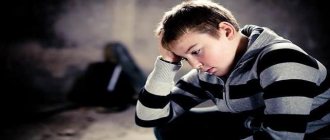What it is
The concept of social maladjustment is interpreted in psychology differently depending on the approach.
Some experts consider it as one of the many borderline neuropsychiatric disorders, when a person, due to his mental characteristics, cannot build relationships with other people in society (due to autism, phobias, personality and behavior disorders). For others, this is a temporary phenomenon that occurs at a moment of crisis as a defensive reaction of the subconscious and passes after it is overcome. So in psychology there is no consensus on the concept of social maladjustment, its types and methods of correction due to an ambiguous approach to the nature of its occurrence. To avoid confusion, it was customary for academic textbooks to give a general definition of this term, reflecting the essence of the phenomenon, but avoiding controversial issues. It sounds like this.
Social maladaptation is the inability to live in society, comply with its norms, and communicate with other people. It means the inability of a person, due to some circumstances, to fulfill his social function, to interact with the microsocial environment in which he finds himself. It manifests itself most clearly at work, at school, at a party, on the street, in stores - wherever you need to communicate with others. As for home, relationships with loved ones suffer when the form is advanced, but in the early stages it may not affect them in any way.
Despite the existence of different approaches to the problem, in psychology this is not considered a pathology, although in some situations it may be a consequence of some serious neuropsychic disorder. But she herself is not one.
Correction
A popular mistake in working to correct maladjustment is fighting the symptoms that have appeared. For example, a child asserts himself through fights. It is useless to punish him for fighting and prohibit him from doing so. Even if he stops fighting, he will do something else, for example, vandalism, since the need for self-affirmation will remain, and the child still does not know the correct methods. Accordingly, the goal of the work is to help the child assert himself in a socially acceptable way.
So what can you do:
- Identify the child’s abilities and interests.
- Identify problems that accompany the need for self-affirmation, for example, uncertainty or fears.
- Help the child overcome problems and do useful and interesting things, for example, join a club, take up drawing or sports, play KVN, and so on.
Using the same principle, you need to work with a child’s aggression and rudeness. Perhaps this is an overcompensation for self-doubt and inability to communicate. Accordingly, we teach how to communicate and be confident - rudeness goes away on its own.
Correction of maladjustment requires an individual approach, which takes into account:
- age characteristics;
- individual personal characteristics;
- manifestations and root causes of maladjustment;
- development environment conditions.
There is no need to be afraid of maladaptation, much less to hush up the problem. Problems in adaptation occur in 15-40% of schoolchildren. Unfortunately, this is a popular problem, but in the early stages it can be easily corrected.
The work should be carried out jointly by parents and school specialists:
- the psychologist draws up recommendations and an individual development plan for the child;
- parents monitor compliance with recommendations within the home (assistance in mastering knowledge, control over the completion of lessons, analysis of missed or incomprehensible material);
- The teacher helps the child in the classroom: creates situations of success, monitors the healthy psychological climate and adherence to an individual-personal approach.
An important role in correcting a child’s maladaptation is played by the individual personal qualities of adults (parents and teachers) and the nature of their interaction. It is important to remember the overall goal - to help the child adapt. The unity of parents and teachers helps to at least reduce the level of anxiety in the child.
Junior schoolchildren
Primary school students are just beginning to move from gaming to educational activities, so games are an excellent form of assistance in adaptation:
- If we are talking about problems in relationships with the team, then games for unity.
- For the development of cognitive processes - intellectual games.
Unity games:
- Orchestra. The game is played by analogy with real conducting: the presenter (conductor) raises and lowers his hands. The higher he raises them, the louder the other children (orchestra) perform the chosen action.
- “Let the one who...” The leader goes to the center of the circle and says, “Let the one who likes to play football (for example) come out to me.” You can name any word: an item of clothing, a hobby, external features.
Educational games should be selected depending on the area in which the gap is noted. Here are some examples:
- For the development of short-term memory. The child is asked to look for 20 seconds at a sheet with drawn figures, remember them and then repeat them on a blank sheet of paper.
- Associations. The child is asked to connect pictures and words according to their meaning, and then give reasons for their decision.
- The “Complete the picture” technique will allow you to determine your creative potential. The child is offered a set of identical (simple level) or different (difficult level) blank figures and is required to complete them. There are no other restrictions. Not only the result of the work is assessed, but also activity, variability, speed of thoughts and actions.
Teenagers
The best method for correcting maladaptation in a teenager is to help him achieve self-realization. To do this, you need to have conversations, organize joint and interesting activities for the teenager, respect his personality and sense of adulthood.
Creativity therapy has proven itself positively. The type of occupation is selected individually. For example, if the problem is not only socio-psychological (uncertainty), but also in the cognitive sphere, then activities that require concentration and develop fine motor skills (sewing, embroidery, weaving) are suitable.
In order to unite the class, it is necessary to use trainings and group consultations. Work should be aimed at developing empathy, reflection, independence (including self-organization).
For example, you can follow this training plan:
- Warm-up and introduction (half an hour). Children get to know each other by playing “Hot Ball”: they throw a ball to each other, say their name and give a compliment to the other person (to whom they throw). Then the leader assesses the readiness of the entire group, the activity of individual participants, and the characteristics of the group’s composition. The game “Arrow” will help with this: the group needs to imagine that they are an arrow (scale), and move towards the maximum or minimum as much as they are ready to work, cheerful, healthy, and so on. Well, in conclusion, the presenter names the topic of the training, voices the problem and describes the essence and goals of the lesson.
- Main part. Depending on the specific conditions, relaxation with the release of the subconscious and imagination, situational role-playing games, simulation games, psychological studies, psychodrama, discussions, metaphors, drawing, and so on are used.
- Reflection. The results of the training are summed up, plans are made for the next lesson (7-8 lessons in total), the thoughts and feelings of the participants are discussed.
Conducting the training is permissible only by a specialist! This method has its own technology and a number of nuances.
General recommendations
Regardless of the child’s age, it is the responsibility of parents, psychologists and teachers to:
- Cooperate with the child, pay more attention, play, advise, observe.
- Preparing a child for school: working on the development of all types of thinking, developing fine motor skills, working on voluntary attention.
- Avoid high expectations and demands, allow the child to be imperfect and make mistakes. Sincerely notice successes without ridicule.
- Do not compare your child with other students, especially more successful ones. A child's success can only be assessed in relation to his previous successes.
- Help the child find a reference group and activities for self-realization. Additional education that matches the interests and capabilities of the child will give self-confidence due to the attention, success, and emotional support that the child will receive in this area. Gradually, self-confidence will spread to all areas of life.
- Make important the area in which the child has better success. Gradually, the attitude “If I am so good here, then I can succeed in another matter” will form.
It must be remembered that any word from an adult has educational power and corrects the behavior and thinking of the student. Both praise and scolding, shouting are tools of reinforcement and provocation to one or another response behavior.
Theory and practice
The problem of social maladaptation is gaining momentum and is more relevant in modern society than ever. This is due to the interests of children and adolescents in social networks and games. The virtual world and Internet communication replace reality and connections with real people. Recently, this has often been observed in adults. In addition, the too sharp division of society into rich and poor has given rise to such a phenomenon as bullying. It also becomes one of the factors because of which a person breaks off all relations with society.
In this regard, numerous studies are being conducted. Psychologists, psychotherapists, sociologists, doctors, and scientists are trying to cover as wide a range of factors as possible that lead to such a disorder of personality and behavior. After all, without eliminating the main cause, its correction is impossible.
Until recently, psychology had a dozen names for a socially maladjusted child: neglected, difficult, dysfunctional, at risk, with behavioral deviations, with a traumatized psyche, with deformed behavior. Today, all these concepts continue to exist, but in most research works they are replaced by the term “maladaptive”. The most interesting thing is that it has also begun to be used in relation to adults who are experiencing problems trying to adapt to the conditions of society, but failing in this.
As researchers of this problem note, the age limit for social maladaptation has become older. If previously it was diagnosed mainly in children and adolescents, today company psychologists say that about 25% of their employees experience serious difficulties in establishing contacts with their colleagues and superiors. These are disappointing figures, forcing specialist scientists to look for new ways to correct this disorder, because not all tools that successfully work on the child’s psyche are just as strong when affecting adults.
Specialists dealing with issues of social maladaptation: Mamaichuk I. I., Belicheva S. A., Grigorenko E. L., Sobkin V. S., Gindikin V. Ya., Kazanskaya V. G., Lichko A. E., Lebedinskaya K. S., Lubovsky V. I., Feldshtein D. I. They have fundamental works on this topic, which include both theoretical calculations and practical methods for correcting the disorder.
Disadaptation in children
The maladaptation of children in modern society is of particular importance. More and more children in developed and developing countries suffer from a variety of behavioral and mental disorders. Most of them cannot adapt normally to society and, as they grow and mature, the number of problems only increases. Moreover, according to experts, only a little more than half of these children suffer from neurological diseases and psychopathologies; in others, disruption of social adaptation occurs due to their living conditions, improper upbringing or lack thereof, as well as the influence of parents and the environment.
Social maladjustment of children and adolescents can have an extremely negative impact on their development - such children cannot establish normal contacts with their peers, and then with the people around them, they develop personality deformations, antisocial tendencies, they may develop a neurological disease or they will not be able to achieve any goals. - success in the future.
Timely correction of such disorders in children and adolescents helps them quickly overcome the state of maladjustment and learn all the necessary skills. In adulthood and in older adolescents, this requires much more time and effort - this is due both to less plasticity of the psyche and to the number of “skills” that need to be replenished.
This has been repeatedly confirmed by numerous studies and practical activities - children at an early age who were in a state of social maladaptation easily and quickly catch up and even outstrip their peers in development when placed in favorable conditions. But for adults who grew up in a state of maladjustment, it is much more difficult to assimilate the necessary information and “join” a more complex society.
RELATED MATERIALS: What to do with attacks of aggression in men
Concepts
Crisis
The most famous concept is the crisis one. Its author is V.V. Kozlov, a Russian psychologist working in the field of social psychology, the founder of “integrative psychology.” In his opinion, this type of maladjustment develops according to the following scheme:
- A person has a tendency to auto-aggressive reactions to difficult (crisis) life situations.
- Each such crisis creates personal negative disintegration.
- It, in turn, becomes overgrown with destructive changes in relationships with others.
- Every time there is an increasing increase in social autism.
According to V.V. Kozlov, auto-aggressive individuals who are not resistant to crisis conditions and ultimately close themselves off from society are susceptible to chronic self-destruction. It most often manifests itself as suicidal tendencies, alcoholism and drug addiction.
Medical
There are a number of psychologists who consider social maladjustment to be a consequence of various mental illnesses. They do not consider it as an independent pathology. Only after a person is diagnosed with behavioral disorders and personality disorders does it manifest itself.
Indeed, with schizophrenia, obsessive-compulsive disorder and other pathologies, it is difficult to establish connections with others. Such people cannot learn the basic rules of behavior in society, the simplest social attitudes. This leads to maladjustment. Accordingly, to eliminate such consequences, psychiatric (most often) treatment is required.
However, this concept does not consider as a separate phenomenon the same adolescent social maladaptation, which usually has nothing to do with physiology. This is the downside of the approach.
Psychological
It is closely related to Kozlov’s crisis concept, as it reflects the processes occurring with the individual. However, with this approach, a person can “fall out” of society without experiencing any crisis. This happens at the moment of realizing that one’s own values do not coexist with the rules of existence in society.
For example, a person by nature does not like submission and total outside control. It is quite natural that with such accentuations it will be difficult for him to get along with his boss at work and constant deadlines. He will do his best to limit his communication with colleagues and his boss. Often such people open their own business and delegate authority to a deputy, enjoying complete freedom.
From the point of view of this approach, it is possible to explain the mechanism of development of any social maladjustment, and this is its undoubted advantage.
Causes
The causes of social maladaptation can be various factors.
Physiological
Social maladjustment is a consequence of various mental disorders:
- psychosis;
- severe neurotic disorders;
- personality and behavior disorders;
- congenital autism.
In this case, correction without treatment of the underlying disease is impossible.
It is also often diagnosed in patients who are undergoing long-term treatment in a psychiatric hospital. This phenomenon is called hospitalism.
Sometimes the cause of maladaptation is a lack of appearance. These could be severe burns on the face, a sloppily sutured cleft lip, protruding ears, obesity, etc. In childhood, isolation is caused by peers who reject a child who is not like them. They refuse to play with him, sit at the same desk, be friends, or invite him somewhere. In such a situation, adults’ internal complexes are triggered, and they themselves, quite consciously, try to avoid communication.
Psychological
- The presence of psychological trauma in childhood: familgeny, sociogeny, didactogeny;
- pedagogical neglect;
- loss of familiar surroundings (when moving, moving to a new school or another place of work);
- conflict of character (impossibility of getting along with someone due to accentuations);
- addictions of various kinds: alcohol, drugs, social networks, computer games;
- replacing the real world with a virtual one.
If social maladaptation is suspected, specialists first of all try to get to the bottom of it, to find out the main reason why it could arise. Sometimes a whole complex of provoking factors is triggered. Typical methods of detection are conversations with psychologists, medical examinations, testing, and sometimes hypnosis.
Levels
First
Names: initial stage, hidden, lower, latent.
Signs: not detected, since everything happens inside a person. He begins to think that he is afraid or does not want to build relationships with others. At this level, the reason why ties with others will subsequently be severed is clearly identified.
How the initial stage of social maladaptation is interpreted in psychology: it is compared with the latent, incubation stage of the disease, when the virus has already entered the body, but is still only preparing the ground for its activation.
Correction: social maladaptation has not yet been diagnosed, but the cause that served as the impetus can be identified and eliminated (if possible). If this happens, a person will be able to continue to easily establish contacts and build relationships in society, living safely according to its rules.
Second
Name: “half” level.
Signs: maladaptive perturbations make themselves felt, but are temporary in nature. A person can lock himself in his room and not leave there for several days, refusing to communicate in person, by phone, or on social networks. But then he behaves as usual: smiles, talks, jokes, meets with friends.
How it is interpreted: as the prodromal period of the disease, when its “harbingers” manifest themselves. But the diagnosis itself is still difficult to make, because the symptoms are too nonspecific and typical of many other ailments. After all, every person at some point may feel bad and will not want to communicate with anyone. This does not mean that he is socially maladjusted.
Correction: if a socially maladjusted person at this stage visits a psychologist or shares his experiences with someone, the specialist and loved ones can see the beginning of a developing problem. You just need to connect the provoking factor and these very “harbingers”. In this case, with the help of conversations and support from friends, the development of deviation can be stopped.
Third
Name: Steadily Incoming.
Signs: social maladaptation manifests itself and becomes noticeable to everyone around. Its characteristic features allow you to clearly see the problem. A person breaks off previous contacts, does not make new ones, and avoids people. From a mental point of view, all those adaptive mechanisms that have been formed over the years up to this point are destroyed.
How it is interpreted: as a period of full development of the disease, when the signs are clearly expressed and allow a correct diagnosis to be made.
Correction: will take a long time, but will lead to successful results. It is impossible without a psychologist and the support of loved ones. The main task is to prevent violations from moving to the next level of development and becoming an established pattern of behavior.
Fourth
Title: entrenched social maladjustment.
Signs: a person’s closedness from others extends to most areas of his life. He may refuse to communicate even with the closest people (parents, children, spouse). Often he stops going to work, school, or the store - just to avoid a collision with society.
How it is interpreted: as the transition of the disease to a chronic form.
Correction: long-term (from six months or more), complicated by stable patterns of behavior. This work must be carried out by a psychologist. In the most advanced cases, a psychotherapist. To get to the bottom of the true reason that led to this, hypnosis is often used.
Symptoms and signs
Disadaptation in psychology is a special condition in which the adaptive functions of the individual are reduced. When it comes to maladaptation in children and adolescents, it is important to identify this condition as early as possible in order to help the child and reduce the negative impact of the emerging behavioral deviation on current and subsequent life.
To do this, it is important for parents and teachers to know what manifestations can be used to identify maladjustment in children. All signs and symptoms indicating this condition can be divided into several groups.
| At the physiological level | If a child has problems adapting to a team, then at the physical level this can be expressed in:
|
| At the cognitive level | Such a child will have difficulty mastering the curriculum in various subjects. Moreover, if a child tries to overcome difficulties, then these attempts will not be successful. Often such children, realizing that something is wrong with them, refuse to study at all. |
| On a sensitive (emotional) level | The child has developed a sharply negative attitude towards school, teachers and peers with whom he is forced to be in the same group. |
| At the behavioral level | Often, when maladjusted, children become impulsive and show aggression. They do not accept established rules and make inadequate demands on teachers and classmates. However, it is worth noting that due to their character traits, not all children with maladjustment behave aggressively; some of them, on the contrary, may become repressed and become unable to defend themselves. |
Peculiarities
In kindergarten
Social maladjustment can occur even in a child who seems very young. Many believe that such a serious psychological phenomenon manifests itself much later, but already at 2-3 years old a child can come into conflict with society. The leading provoking factor is spoilage and improper upbringing.
If dust particles are blown off him at home and every whim is fulfilled on demand, he definitely will not want to share a dustpan and bucket with other children on the playground. He will be hysterical in the store so that they buy him a toy. It will become problematic for nannies and teachers, as it will refuse to sleep during the day, eat porridge, go for a walk with everyone, etc. If correction is not carried out at this stage, such a child will definitely begin to put himself above the rest and will not be able to accept the rules of the microsociety .
At school
The most striking manifestations of social maladjustment are observed at school. Almost every class has an outcast child. Sometimes he puts himself in such a way that others do not want to communicate with him. The reasons may be different: again, spoiled behavior and high self-esteem, replacement of the real world with a virtual one, autism.
But most often he fails to get along with his peers, because they are the ones who do not accept him because of his bad character, poverty, some disgusting habit, and even simply because he is not like everyone else (with some external defects ). The child cannot establish relationships at first only with peers, but then this problem spreads to adults. He becomes angry with the whole world due to constant bullying, and withdraws into himself.
In teenagers
In adolescence, this problem is especially acute. If a child in elementary school was unable to get used to the micro-society of the class, he continues to carry this baggage until graduation. Growing up, every year he perceives his own isolation more and more sensitively. Disadaptation deepens and becomes a stable pattern. This leads to problems such as truancy, deviant behavior, inability to communicate and compromise. The worst consequence is suicide.
Because of all this, the situation at home is heating up, and quarrels with parents occur. If in such a situation a teenager does not receive specialist help and support from family, this leads to serious psychological disorders of personality and behavior.
According to statistics, more than 60% of children and adolescents experienced maladjustment in school society at some point in their lives. However, 40% of them overcame crises and personal accentuations and found a way out with the help of psychologists, parents, and friends. The remaining 20% had to live with it.
In adults
Still, age has a certain influence on social maladjustment. According to statistics, after 30 years it practically disappears from the radars of psychologists. That is, in the older generation it is diagnosed extremely rarely and only due to emergency circumstances (due to a discovered disease or severe psychological trauma). This is explained by the fact that an adult, due to his age and experience, assimilates the norms of society and has already established contacts that have been tested by time.
But among young people, social adaptation is clearly expressed during studenthood (18-19 years old) and employment (at about 25 years old). The first crisis is associated with the fact that you have to go to study in another city, fly away from your familiar and so cozy parental nest. The school system and college/institute education are very different. Often those who were stars in the class become nobody in the new team. This leads to disappointment, changes in personal guidelines and, as a result, social maladjustment.
When applying for a job, the leading accentuation is the discrepancy between expectations and reality. Most students immediately after receiving their diploma expect a high salary, career growth, a dust-free office position and many other amenities. But the reality turns out to be more cruel. Some squeeze themselves into the framework of the demands of a new microsociety, others have to look for other ways to cope with their maladjustment.
Character accentuations
Separately, it is worth revealing the features of social maladaptation with character disorders, when a person is prevented from adapting to social norms by his own accentuations.
- Hyperthymic / demonstrative personality type
A person needs to constantly be in the spotlight. If it is absent and in some group he is perceived as nothing more than a gray mouse, this can lead to maladjustment.
- Dysthymic/introverted
Tendency to live a lonely lifestyle. Disadaptation in society does not bother such people at all. They are even glad of their isolation.
- Affectively labile
Constant mood swings make such a person impossible to communicate, as he changes too abruptly and for no reason. Therefore, his circle of friends gradually dwindles to nothing.
- Emotive / excitable / stuck
Too emotional, sensitive, easily wounded, taking everything to heart. Such a person is capable of refusing to communicate because of one sidelong glance, a careless word, or a comment on the work done.
- Anxious
Cannot make decisions in difficult situations. Any crisis can disable him socially.
- Exalted
Bright, shocking personalities, oddly enough, most often turn out to be socially maladapted, although they themselves do not suspect it and live with it all their lives. They cannot fit their behavior into the framework of norms established by society. And everyone ends up meeting “for an hour.”
Prevention of maladaptive states in children and adolescents in secondary schools
The article examines the relevance of the problem of school maladjustment in children and adolescents, and analyzes the nature of the occurrence and characteristic manifestations of maladjustment in childhood and adolescence. The main directions of pedagogical work on the prevention of maladaptive states in secondary school students are proposed.
Key words: school maladjustment, social adaptation, prevention of maladjustment.
The reform of political and socio-economic life in Kazakhstan, which began in the early 90s, led not only to progressive structural changes in the country, but also to the aggravation of various social problems caused by the acceleration of the rhythm of life in modern society. One of these social problems includes problems associated with the emergence of behavioral deviations in today's children and adolescents and the presence of negative mental states, which are based on maladaptive processes. School maladjustment, being part of social maladjustment, is currently a fairly common phenomenon among children and adolescents in our society, which can negatively affect their development as a whole, since social adaptation is an integral indicator of a person’s condition, reflecting his ability to perform certain biosocial tasks. functions. Such functions include a person’s adequate perception of the surrounding reality and himself, an adequate system of relationships with people around him, the ability to do socially useful work, learning, to organize his own leisure and recreation, variability of behavior in accordance with the role expectations of other people [1].
The term “maladaptation” is interpreted as a socio-psychological and socio-pedagogical phenomenon of a child’s failure in learning, associated with a subjectively insoluble conflict for him between the requirements of the educational environment and immediate environment and his psychophysical capabilities and abilities. A child’s failure in educational activities and problems in relationships with personally significant people have a negative impact on the socio-psychological well-being of his entire personal development [2].
When organizing preventive work for maladaptive states in children and adolescents in an educational institution, it should be taken into account that the main factors in the occurrence of maladaptive states include: learning difficulties, family dysfunctions, neuropsychiatric diseases, behavioral deviations, and the imbalance of the modern educational environment. In this regard, the issue of not only studying the nature of the occurrence and characteristic manifestations of social maladjustment, but also determining effective ways and means of its prevention in children's and adolescents' environment of educational institutions becomes particularly relevant. The main idea of prevention is to eliminate social preconditions that contribute to the formation of maladaptive states and take timely measures to preserve the mental health of schoolchildren through the implementation of special psychological and pedagogical work.
The educational process should include psychological and pedagogical support aimed at preventing maladaptive states of students: overwork, physical inactivity, distress, etc.
Adaptation is the process of students actively mastering new learning conditions in order to adapt them to their individual needs and capabilities. The state of social maladaptation is characterized by problems in the social and personal development of the child, which negatively affect the nature of interpersonal relationships with family, teachers and peers. At the same time, social maladjustment develops step by step in two spheres - the activity sphere and the sphere of relationships [3].
Thus, under unfavorable social and psychological-pedagogical conditions, the formation of maladjustment in children and adolescents in educational activities includes five interrelated stages: primary difficulties in learning; knowledge gaps; delay in mastering the program in one or more subjects; partial or total academic failure; refusal of educational activities, i.e. failure to attend training sessions.
Maladjustment in children and adolescents also manifests itself in difficulties caused by the need to assimilate various social roles, curricula, norms and requirements of social institutions such as family and school.
A systematic lack of success in educational activities and increasing tension in relationships with loved ones negatively affect the psychological well-being of the child as a whole. In situations of constant failures in educational activities, it ceases to be significant for the child, so he begins to look for the type of activity in which he would be more successful and could reveal his personal potential (leisure activities, sports, informal teenage groups, etc.). d.) [4].
In the structure of maladjustment, the following main components can be distinguished: cognitive, emotional-personal, behavioral (Table 1).
Table 1
The structure of childhood and adolescent maladjustment
| Components of maladjustment | Content characteristics |
| Cognitive | difficulties in educational activities, unformed or low level of cognitive processes, low performance in certain academic subjects |
| Emotional-personal | negative subjective attitude towards individual subjects and teaching in general, teachers |
| Behavioral | violation of academic discipline, behavior in the sphere of interaction with teachers and peers |
The main reasons for the formation of maladaptive states in children and adolescents include:
psychophysiological and cognitive factors: individual temperamental properties, increased anxiety, low level of voluntariness, attention, thinking, memory and behavior, psychological and functional unpreparedness for the conditions and requirements of the educational process, mental and physical health disorders.
social: a change in the child’s role position, the child’s assimilation of a system of new school requirements, a variety of educational requirements, an increase in the level of complexity of the training program, an increase in intellectual and psycho-emotional load, a change in the parental position in relation to the child, violation of the regime, etc. [5].
In psychological and pedagogical work to prevent maladaptive states in children and adolescents, two main strategic goals must be realized:
1) facilitating the adaptation of all children, without exception, to school;
2) prevention of maladaptive states in students.
Work on the prevention of maladjustment in children and adolescents should be of a purely individual nature, based on a comprehensive analysis of the causes of maladaptation of a particular student, which may be associated with the characteristics of both the psyche of the student himself and the conditions of the surrounding socio-educational environment [6].
There is a certain algorithm for preventing student maladaptation, which includes the following main stages (Figure 1) [7]:
Rice. 1. Algorithm for preventing student maladjustment
When carrying out diagnostic work, the time frame should be taken into account, since with children of primary school age, diagnostics cannot be carried out for more than 30–40 minutes; with adolescents, diagnostics can be carried out in 2 stages, each lasting no more than one hour. Psychological diagnostics of the characteristics of the behavioral and personal profile of students allows us to identify such characteristic aspects as: the level of adaptation of the student to the conditions of the school; range of current problems in the educational activities of schoolchildren; the student's attitude towards himself; emotional and behavioral problems of the child; features of the student’s interpersonal relationships with peers, i.e., determination of his social status.
The obtained indicators make it possible to determine the most effective ways of correctional work within the framework of the educational process, to specify the tasks of preventing the formation of maladaptive states (overwork, physical inactivity, distress) in children and adolescents, as well as to identify a “risk group” for in-depth diagnostic and enhanced pedagogical correction -developmental work, the directions of which are presented below (Table 2).
It should be taken into account that, along with the described manifestations of school maladjustment, there are also its hidden forms, when, with sufficiently good academic performance and discipline, the child experiences constant internal anxiety and fear of school or a specific teacher, he has no desire to go to school, there are difficulties in communication, inadequate (usually low) self-esteem. In this case, it is necessary to develop a slightly different correctional and pedagogical program to eliminate such maladaptive states, based on an analysis of the individual reasons for their occurrence.
table 2
Direction of pedagogical work with children with signs of school maladjustment
| Variants of manifestation of maladjustment | Recommendations for teachers |
| They cannot independently convey their thoughts to communication partners and formulate answers to questions asked of them, as well as independently formulate questions to their interlocutor. During disputes that arise, they behave incorrectly. They are not able to defend their own position with reason and change it, because they do not realize the need for this. When interacting with the class, they do not obey the general decision of the group. They cannot build a communication process taking into account the status of the interlocutor and the characteristics of a particular communication situation. | It is necessary to teach adequate methods of participation in a discussion, to develop in children the ability to competently and correctly justify their position in a dispute, to see the common goal of the group and act in accordance with it, to maintain social distance during communication with adults (parents, teachers, etc.) and peers . |
| When perceiving educational information, they cannot act independently. Information presented in writing causes particular difficulties. They experience great difficulty in identifying what is new and important when analyzing educational information. The pace of intellectual activity and its effectiveness are noticeably reduced. Mastering the school educational program is significantly difficult. | A step-by-step (dosed) presentation of educational information with constant step-by-step monitoring of its assimilation is necessary. When processing information intellectually, additional teaching, organizing and stimulating assistance from a teacher is necessary. It is necessary to develop the level of logical thinking. |
| It is difficult to understand the educational task as the goal of the activity. They start work without a clear plan of action. No clarifying questions are asked, although additional clarification is needed. They act not systematically, but impulsively and chaotically. If the work algorithm is proposed by the teacher, during the work they grossly violate it without noticing it. Having completed a task, they are often satisfied with the erroneous result, but when checking the result, they do not see any mistakes made. They are not able to seek the necessary additional help from the teacher, and even if such help is provided, they do not know how to use it. | It is necessary to teach the ability to set a goal for an activity and develop a plan to achieve it. Upon completion of the work, children should be encouraged to compare their own results with the sample, find and correct mistakes, and on this basis give a self-assessment of the work performed. Children should be shown where they can get additional help and how to use it correctly. |
Thus, the main directions of preventive and correctional-developmental work with children in the aspect of interpersonal relationships with peers include:
development of self-knowledge of children and adolescents in various social situations, determination of their position and methods of adequate behavior in them;
training in the skills of analyzing various communication situations;
training in emotional self-control skills in communication;
creating conditions for children and adolescents to turn to their own communication experience;
teaching children and adolescents the skills of effective interaction in conflict.
Only such an integrated approach ensures the necessary effectiveness of psychological and pedagogical work to prevent maladaptive states in children and adolescents and their correction.
Literature:
- Kazanskaya V. G. Teenager: social adaptation. - St. Petersburg: Peter, 2011.
- Ageeva L.G. Socio-psychological disadaptation of modern adolescents and its causes. - Ulyanovsk: 2010.
- Sharapanovskaya E. V. Socio-psychological disadaptation of children and adolescents. - M.: Sfera, 2005.
- Galushina E., Komarova O. Game for teenagers “What is the meaning of life” // School psychologist, 2005, No. 5.
- Korchuganova I.P. Professional development and support for teachers working with “at-risk” children: Methodological manual. - St. Petersburg, 2006.
- Krylova T. A., Strukova M. L. Social and pedagogical technologies in working with children and families at risk. - M.: Research Institute "School Technologies", 2010, - pp. 26–52.
- Cheprakova E. A. Development of correctional and developmental programs. — // Handbook of educational psychologist. School. — 2012, No. 4.
Correction and prevention
Social maladjustment can be easily corrected with the help of a specialized specialist, family and friends. The most effective ways:
- Creating a favorable environment in the family, school, and at work.
- A special course of consultations with a psychologist. If necessary, hypnosis to identify the provoking factor. Working on eliminating it.
- Restoring previous social contacts.
- New acquaintances.
- Finding interests and hobbies - this forces a person to find people with common interests.
- Finding a permanent official job.
- Auto-training to combat your own complexes, doubts, and fears.
- Trainings on monitoring and managing your own character accentuations.
- Trainings to develop communication skills.
- Psychotechnical classes for multifaceted personality development.
If the cause is physiological, in the presence of mental disorders, the person is sent to see a psychiatrist, where he undergoes a course of therapy.
Prevention of social maladjustment should be carried out in two directions. Firstly, through the assimilation of norms and rules of behavior in society. In childhood, parents, educators, teachers, and school psychologists are responsible for this. Adults themselves must learn to tame their own accentuations. Secondly, it is necessary to constantly monitor your mental health. After all, if problems start with him, then a full life in society may turn out to be impossible.
Prevention and correction of school maladjustment
Children who have problems with school adaptation most often get tired quickly, find it difficult to concentrate, and their memory, attention and thinking may be reduced. All this leads to incomplete assimilation of educational material. It is easier for a child to complete independent work one on one with a teacher; those tasks that cause difficulties for the child can be completed at home. This is due to the fact that the home stop is more comfortable, it is easier for the child to concentrate and tune in to the right mood.
Note 1
There is currently no unified method for correcting school maladaptation. This problem must be solved comprehensively, taking into account pedagogical, psychological, medical and social aspects.
The main specialist who deals with this problem is a school psychologist. To begin with, the psychologist must learn more about the life of the child himself and identify factors that could contribute to the formation of school maladjustment. Next, the psychologist draws up a program that will help correct the child’s behavior while taking into account his individual abilities and inclinations.
Social maladjustment
This term has firmly entered the life of modern man. Surprisingly, with the development of information technology, many people feel lonely and unadapted to the external conditions of reality. Some people get lost in completely ordinary situations and don’t know how best to act in this or that case. Currently, cases of depression among young people have become more frequent. It would seem that there is a whole life ahead, but not everyone wants to be active in it and overcome difficulties. It turns out that an adult has to learn to enjoy life again, because he is rapidly losing this skill. The same applies to depression in children who exhibit maladjustment. Today, teenagers prefer virtual communication and fulfill their communication needs on the Internet. Computer games and social networks partially replace normal human interaction.
Social maladaptation is usually understood as the complete or partial inability of an individual to the conditions of the surrounding reality. A person suffering from maladjustment cannot interact effectively with other people. He either constantly avoids all contact or demonstrates aggressive behavior. Social maladaptation is characterized by increased irritability, inability to understand another and accept someone else’s point of view.
Social maladaptation occurs when a particular person stops noticing what is happening in the outside world and is completely immersed in an imagined reality, partially replacing relationships with people with it. Agree, you can’t completely focus only on yourself. In this case, the opportunity for personal growth is lost, since there will be nowhere to draw inspiration or share your joys and sorrows with others.
Afterword
If the child is happy with school and his whole life, then there will be no problems. This means that all work should be aimed at developing a positive attitude of the child towards life, himself, the environment, school and all participants in the educational process. Any activity that is significant to the child’s personality and gives him positive emotions, including communication as a separate activity, will help with this.
Read more about successful school adaptation, its signs and the role of parents in this, in the article “Psychological features of a child’s adaptation to school. Types and levels of adaptation." About the signs and factors of maladaptation - in the article “School maladjustment: what is it, causes and signs.”
Causes of social maladjustment
Any phenomenon always has good reasons. Social maladjustment also has its reasons. When everything is good inside a person, he is unlikely to avoid communicating with his own kind. So maladaptation, to one degree or another, always indicates some social disadvantage of the individual. Among the main causes of social maladaptation, the following most common ones should be highlighted.
Pedagogical neglect
Another reason is the demands of society, which a particular individual cannot justify in any way. Social maladaptation in most cases appears where there is inattention to the child, lack of proper care and concern. Pedagogical neglect means that little work is done with children, and therefore they can withdraw into themselves and feel unnecessary to adults. As he grows older, such a person will probably withdraw into himself, go into his inner world, close the door and not let anyone in. Disadaptation, of course, like any phenomenon, develops gradually, over several years, and not instantly. Children who experience a subjective feeling of worthlessness at an early age will subsequently suffer from the fact that others do not understand them. Social maladaptation deprives a person of moral strength, takes away faith in himself and his own capabilities. The reason should be sought in the environment. If a child has pedagogical neglect, there is a high probability that, as an adult, he will begin to experience enormous difficulties with self-determination and in finding his place in life.
Loss of familiar team
Sometimes it happens that a person drops out of society due to a long-term illness or a change in occupation. Social maladaptation does not begin immediately, but after some time. It’s just that a person suddenly begins to notice that he doesn’t want to leave the house again, take care of himself, perform some routine duties, or meet someone. A person focuses on himself and immerses himself in work. Gradually he gets used to acting alone; the presence of anyone begins to greatly interfere and even irritate him. Disadaptation gradually increases, various fears associated with other people and interactions in general appear. Creative people, for example, are forced to spend a lot of time alone with themselves. This is the only way they can draw an inexhaustible source of inspiration, and then realize it in the products of their work. But not everyone knows how hard it is for them when all day long there is no one to say a word to, to share their joy or sadness with.
Conflict with the environment
It happens that a particular individual challenges an entire society. In this case, he feels unprotected and vulnerable. The reason is that additional experiences are placed on the psyche. This condition comes as a result of maladjustment. Conflict with others is incredibly exhausting and keeps a person at a distance from everyone. Suspicion and mistrust are formed, character in general deteriorates, and a completely natural feeling of helplessness arises. Social maladjustment is only a consequence of a person’s incorrect attitude to the world, the inability to build trusting and harmonious relationships. Speaking about maladjustment, we should not forget about the personal choices that each of us makes every day.
School maladjustment in adolescence
During adolescence, the situation most often worsens. Students' performance begins to decline and more problems with discipline appear. During this period, a number of factors begin to affect the process of normal adaptation that lead to its disruption
The first factor is the individual factor. It should be noted that during this period, adolescents experience a strong hormonal surge, which affects their attitude, behavior, physical and emotional state. Some strive to take a leading position, they realize this desire through antisocial behavior, try to demonstrate their maturity through incorrect behavior, start smoking or drinking alcohol, and using obscene language.
The next factor is the mental factor. During this period, emotions take precedence over rationality. The child decides to do for himself what brings him more pleasure and thinks less about the benefits.
The next factor is the volitional factor. A teenager begins to have problems with water power. He often cannot bring himself to do what he needs to do; more often he does what he wants. If the goal is not attractive to him, then most often the work remains unfinished.
The last factor is the family factor. During adolescence, children try to appear independent. If there are good relationships in the family, then the child does not move away from relatives and seeks help and support when necessary. If family relationships have become complicated, then the teenager has no one to share his problem with.
Types of social maladjustment
Disadaptation, fortunately, does not happen to a person at lightning speed. It takes time for self-doubt to develop, for significant doubts to settle in your head about your appearance and the activities you perform. There are two main stages or types of maladjustment: partial and complete. The first type is characterized by the beginning of the process of falling out of public life. For example, as a result of illness, a person stops going to work and is not interested in current events. However, he maintains contact with relatives and possibly friends. The second type of maladaptation is characterized by loss of self-confidence, strong distrust of people, loss of interest in life and any of its manifestations. Such a person does not know how to behave in society, does not understand its norms and laws. He gets the impression that he is constantly doing something wrong. Often, people with some kind of addiction suffer from both types of social maladjustment. Any addiction presupposes a separation from society, the erasing of familiar boundaries. Deviant behavior is always, to one degree or another, associated with social maladjustment. A person simply cannot remain the same when his inner world is destroyed. This means that many years of built-up connections with people: relatives, friends, and immediate circle are also destroyed. It is important to prevent the development of maladjustment in any form.
Prevention
Prevention also includes actions aimed at children who have shown the first signs of social maladaptation
- Primary. Aimed at preventing the development of possible problems and unfavorable conditions that may influence the formation of maladjustment.
- Secondary. Aimed at recognizing early manifestations of maladjustment, reducing the impact of bad factors, and working with children who are at risk.
- Tertiary. Carrying out special events in the presence of signs of maladjustment that have already appeared. Aimed at preventing the formation of new manifestations.
Now you know what the causes of social maladjustment are. Knowing them, a person is able to prevent the development of such a condition. If you notice characteristic manifestations in yourself, then it is better not to remain idle, but to immediately begin making adjustments in order to prevent the consequences from developing.
Features of social maladjustment
Speaking about social maladjustment, one should keep in mind the fact that there are some features that are not as easy to overcome as it might seem at first glance.
Sustainability
A person who has been subjected to social maladjustment cannot quickly re-enter the team even with a strong desire. He needs time to build his own prospects, accumulate positive impressions, and form a positive picture of the world. A feeling of uselessness and a subjective feeling of being disconnected from society are the main features of maladjustment. They will continue to pursue you for a long time and will not let you go. Maladjustment actually causes a lot of pain to the individual, because it does not allow him to grow, move forward, and believe in the possibilities available.
Focus on yourself
Another feature of social maladaptation is a feeling of isolation and emptiness. A person who experiences complete or partial maladjustment is always extremely focused on his own experiences. These subjective fears create a feeling of uselessness and some detachment from society. A person begins to be afraid to be among people and make certain plans for the future. Social maladaptation assumes that a person is gradually destroyed and loses all connections with his immediate environment. Then it becomes difficult to communicate with any people, you want to run away somewhere, hide, disappear into the crowd.
Signs of social maladjustment
What signs can be used to understand that a person has maladjustment? There are characteristic signs indicating that a person is socially isolated and experiencing some trouble.
Aggression
The most striking sign of maladjustment is the manifestation of negative feelings. Aggressive behavior is characteristic of social maladjustment. Since people are outside of any group, they eventually lose the skill of communication. The individual stops striving for mutual understanding; it becomes much easier for him to get what he wants through manipulation. Aggression is dangerous not only for the people around you, but also for the person from whom it comes. The fact is that by constantly showing dissatisfaction, we destroy our inner world, impoverish it to such an extent that everything begins to seem tasteless and faded, devoid of meaning.
Withdrawal
Another sign of a person’s maladaptation to external conditions is pronounced isolation. A person stops communicating and counting on the help of other people. It becomes much easier for him to demand something rather than decide to ask for a favor. Social maladaptation is characterized by the absence of firmly built connections, relationships and desires to make new acquaintances. A person can be alone for a long time, and the longer this continues, the more difficult it becomes for him to return to the team and be able to restore broken connections. Withdrawal allows the individual to avoid unnecessary confrontations that could negatively affect mood. Gradually, a person gets used to hiding from people in his usual environment and does not want to change anything. Social maladaptation is insidious in that at first it is not noticed by the individual. When a person himself begins to realize that something is wrong with him, it is already too late.
Social phobia
It is a consequence of an incorrect attitude to life and almost always characterizes any maladjustment. A person stops building social connections and over time he has no close people left who would be interested in his inner state. Society never forgives individuals for dissent, the desire to live only for themselves. The more we tend to focus on our problem, the more difficult it subsequently becomes to leave our cozy and familiar little world, which already functions, it would seem, according to our laws. Social phobia is a reflection of the internal way of life of a person who has been subjected to social maladjustment. Fear of people and new acquaintances is due to the need to change the attitude towards the surrounding reality. This is a sign of self-doubt and the fact that a person is experiencing maladjustment.
Reluctance to comply with society's demands
Social maladjustment gradually turns the individual into a slave of himself, who is afraid to go beyond the boundaries of his own world. Such a person has a huge number of limitations that prevent him from feeling like a full-fledged happy person. Disadaptation forces you to avoid all contact with people, and not just build serious relationships with them. Sometimes it gets to the point of absurdity: you need to go somewhere, but the person is afraid to go outside and comes up with various excuses for himself so as not to leave a safe place. This also happens because society dictates its requirements to the individual. Disadaptation forces one to avoid such situations. It becomes important for a person only to protect his inner world from possible attacks from other people. Otherwise, he begins to feel extremely uncomfortable and uncomfortable.
Condition correction
New acquaintances and communication with other people are a method of combating diabetes
- Creating social contacts is important.
- If there is no one left among your acquaintances, try to meet someone new, try to communicate wherever possible. There is no need to be afraid that you will be perceived as a stupid person, remain yourself.
- Find yourself a hobby, go to a specialized club. Attend trainings and courses. There you can find people with similar interests and make new acquaintances.
- Try to get a permanent job to form a social circle. Realize that without live communication it is impossible to exist normally.
- Conquer your doubts and fears. If you can’t cope with them on your own, seek help from a psychologist.
- Correction of this condition in children includes special trainings that teach the development of communication skills, psychotechnical classes, personality development from different sides, and relaxation.
Correction of social maladjustment
The problem of maladjustment definitely needs to be worked on. Otherwise, it will only rapidly increase and increasingly hinder human development. The fact is that maladaptation in itself destroys the personality and forces it to experience the negative manifestations of certain situations. Correction of social maladjustment lies in the ability to work through internal fears and doubts, and bring a person’s painful thoughts to light.
Social contacts
Before maladaptation has gone too far, you should begin to act as soon as possible. If you have lost all connections with people, start getting acquainted again. You can communicate everywhere, with everyone and about anything. Don't be afraid to seem stupid or weak, just be yourself. Get yourself a hobby, start attending various trainings and courses that interest you. There is a high probability that this is where you will meet like-minded people and like-minded people. There is no need to fear anything, let events develop naturally. To constantly be in a team, get a permanent job. It’s difficult to live without society, and your colleagues will help you solve various work issues.
Working through fears and doubts
Anyone who suffers from maladaptation necessarily has a whole set of unresolved issues. As a rule, they concern the individual himself. A competent specialist - a psychologist - will help in such a delicate matter. Disadaptation cannot be left to chance; its condition must be monitored. A psychologist will help you deal with your inner fears, see the world around you from a different angle, and make sure of your own safety. You won’t even notice how the problem will leave you.
School maladjustment: concept, factors, causes, types
Definition 1
School maladaptation is understood as a violation of the student’s acquisition of knowledge and skills and the inability to master the active skills of collective learning activities in an educational institution.
There are several factors that contribute to the development of school maladjustment:
- social factor
- psychological factor
- medical factor
There are also several reasons for the appearance of school maladjustment. One reason may be brain dysfunction. Another reason may be neuroses and neurosis-like conditions.
School maladjustment has several types of manifestation. The first type manifests itself in the fact that the child does not keep up with the school curriculum. The child's cognitive component is not developed.
Finished works on a similar topic
- Course work Pedagogical conditions for the prevention and correction of social and school maladjustment 430 rub.
- Abstract Pedagogical conditions for the prevention and correction of social and school maladaptation 230 rub.
- Test work Pedagogical conditions for the prevention and correction of social and school maladaptation 240 rub.
Receive completed work or specialist advice on your educational project Find out the cost
The second type of school maladaptation manifests itself in the fact that the child experiences a violation of his personal attitude towards certain subjects and teachers. The child has not developed the emotional, evaluative and personal component.
The third type of school maladaptation manifests itself in violations of discipline during the learning process. In this case, the behavioral component is not developed.
Disadaptation
Disadaptation
a mental state that arises as a result of a discrepancy between the sociopsychological or psychophysiological status of a child and the requirements of the new social situations. S.A. Belicheva, depending on the nature, character and degree of violations of social adaptation, distinguishes: 1) pathogenic maladaptation that occurs with deviations in mental development and neuropsychiatric diseases, which are based on functional-organic lesions of the central nervous system; 2) psychosocial maladaptation associated with the gender, age and individual psychological characteristics of the student (crisis phenomena, character accentuations, features of the emotional-volitional, cognitive and motivational spheres). These features make him a certain non-standard, difficult to educate, requiring an individual pedagogical approach and, in some cases, special psychological and pedagogical correctional programs that can be implemented in a family, educational institution and other social institutions; 3) social disadaptation, expressed in violation of moral and legal norms, in asocial forms of behavior and deformation of the internal regulation system, referent and value orientations, and social attitudes. When the socialization process is disrupted, a phenomenon such as a student’s educational maladaptation is observed, which is expressed in his persistent educational failure, severance of ties with the educational institution, leading to the individual’s lack of formation of cognitive motives, interests and educational skills.
Rate the definition: Excellent definition – Incomplete definition ↓
Source: Pedagogical encyclopedia “Education of a healthy lifestyle for students”
School maladaptation in younger schoolchildren
Experts identify several forms characteristic of school maladjustment in children of primary school age. Firstly, the child may not be capable of educational activities due to the fact that he has insufficient intellectual and psychomotor development. The child does not receive proper attention and support from adults. Secondly, the child may not be able to regulate his behavior; this may be due to improper family upbringing. Thirdly, some children are unable to keep up with the school pace of learning. This can occur in children with developmental delays and children with a weak nervous system. The fourth form of school maladaptation may consist in fear of school as such.
Do you need proofreading or review of academic work? Ask a question to the teacher and get an answer in 15 minutes! Ask a Question











